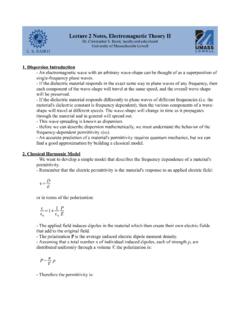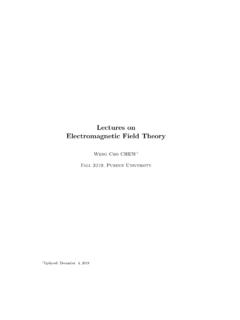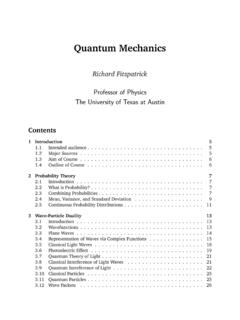Transcription of Information Theory - MIT
1 Aftab, Cheung, Kim, Thakkar, Yeddanapudi Information Theory & THE DIGITAL REVOLUTION 1. Information Theory Information Theory AND THE DIGITAL AGE. AFTAB, CHEUNG, KIM, THAKKAR, YEDDANAPUDI. FINAL PAPER. Project History, Massachusetts Institute of Technology Aftab, Cheung, Kim, Thakkar, Yeddanapudi Information Theory & THE DIGITAL REVOLUTION 2. introduction . Information Theory is one of the few scientific fields fortunate enough to have an identifiable beginning - Claude Shannon's 1948 paper. The story of the evolution of how it progressed from a single theoretical paper to a broad field that has redefined our world is a fascinating one.
2 It provides the opportunity to study the social, political, and technological interactions that have helped guide its development and define its trajectory, and gives us insight into how a new field evolves. We often hear Claude Shannon called the father of the Digital Age. In the beginning of his paper Shannon acknowledges the work done before him, by such pioneers as Harry Nyquist and RVL. Hartley at Bell Labs in the 1920s. Though their influence was profound, the work of those early pioneers was limited and focussed on their own particular applications. It was Shannon's unifying vision that revolutionized communication, and spawned a multitude of communication research that we now define as the field of Information Theory .
3 One of those key concepts was his definition of the limit for channel capacity. Similar to Moore's Law, the Shannon limit can be considered a self-fulfilling prophecy. It is a benchmark that tells people what can be done, and what remains to be done compelling them to achieve it. What made possible, what induced the development of coding as a Theory , and the development of very complicated codes, was Shannon's Theorem: he told you that it could be done, so people tried to do it. [Interview with Fano, R. 2001]. In the course of our story, we explore how the area of coding, in particular, evolves to reach this limit.
4 It was the realization that we were not even close to it that renewed the interest in communications research. Information Theory was not just a product of the work of Claude Shannon. It was the result of crucial contributions made by many distinct individuals, from a variety of backgrounds, who took his ideas and expanded upon them. Indeed the diversity and directions of their perspectives and interests shaped the direction of Information Theory . In the beginning, research was primarily theoretical, with little perceived practical applications. Christensen says that the innovator's dilemma is that he cannot garner support for his new ideas because he cannot always guarantee an end profit.
5 Fortunately, Information Theory was sponsored in anticipation of what it could provide. This perseverance and continued interest eventually resulted in the multitude of technologies we have today. In this paper, we explore how these themes and concepts manifest in the trajectory of Information Theory . It begins as a broad spectrum of fields, from management to biology, all believing Information Theory to be a 'magic key' to multidisciplinary understanding. As the field moved from this initial chaos, various influences narrowed its focus. Within these established boundaries, external influences such as the space race steered the progress of the field.
6 Through it all, the expansion of Information Theory was constantly controlled by hardware Project History, Massachusetts Institute of Technology Aftab, Cheung, Kim, Thakkar, Yeddanapudi Information Theory & THE DIGITAL REVOLUTION 3. technological limitations indeed, the lack of such technology caused the death' of Information Theory , and its widespread availability is behind its current overwhelming success. SHANNON'S MATHEMATICAL Theory OF COMMUNICATION . Before 1948, there was only the fuzziest idea of what a message was. There was some rudimentary understanding of how to transmit a waveform and process a received waveform, but there was essentially no understanding of how to turn a message into a transmitted waveform.
7 [Gallager, Claude Shannon: A Retrospective, 2001 pg. 2683]. In 1948, Shannon published his paper A Mathematical Theory of Communication in the Bell Systems Technical Journal. He showed how Information could be quantified with absolute precision, and demonstrated the essential unity of all Information media. Telephone signals, text, radio waves, and pictures, essentially every mode of communication, could be encoded in bits. The paper provided a blueprint for the digital age 1. Since the Bell Systems Technical Journal was targeted only towards communication engineers, mathematician Warren Weaver had the feeling that this ought to reach a wider audience than (just) people in the field recalls Betty Shannon2.
8 He met with Shannon, and together, they published The Mathematical Theory of Communication in 1949. The change from A to The established Shannon's paper as the new scripture on the subject it allowed to reach a far wider group of people. Why was Shannon's paper so influential? What was it about this paper that people refer to it as one of the greatest intellectual triumphs of the twentieth century? The answer lies in the groundbreaking concepts that A Mathematical Theory of Communication contains. Concepts that were influential enough to help change the world. There are actually four major concepts in Shannon's paper.
9 Getting an idea of each is essential in understanding the impact of Information Theory . Channel Capacity & The Noisy Channel Coding Theorem Perhaps the most eminent of Shannon's results was the concept that every communication channel had a speed limit, measured in binary digits per second: this is the famous Shannon Limit, exemplified by the famous and familiar formula for the capacity of a White Gaussian Noise Channel: P+N. C t = W log 2. N. 1. Gallager, R. Quoted in Technology Review, 2. Shannon, B. Phone Interview Project History, Massachusetts Institute of Technology Aftab, Cheung, Kim, Thakkar, Yeddanapudi Information Theory & THE DIGITAL REVOLUTION 4.
10 The bad news is that it is mathematically impossible to get error free communication above the limit. No matter how sophisticated an error correction scheme you use, no matter how much you can compress the data, you can not make the channel go faster than the limit without losing some Information . The good news is that below the Shannon Limit, it is possible to transmit Information with zero error. Shannon mathematically proved that there were ways of encoding Information that would allow one to get up to the limit without any errors: regardless of the amount of noise or static, or how faint the signal was.

















